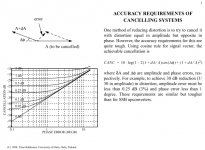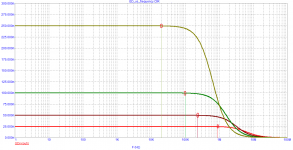It was a joke/rhetorical question. Use the search function if you really want to know. He also has a problem understanding the difference in voltage and current phases and thinks they are of much greater significance than they are.Who is he?
You need to be aware that there are internet shills for audio business. They devised series of internet talks that are geared towards supporting the boutique audio electronics market. Many of them are pro at it and they've invested a lot of time crafting word salad to make it look "delicious".Se how there's no way around actual measurements to proof a theory, otherwise it's just a thought experiment and of no real value to people developing circuits to sound better and verifying their improvements.
All signals you find in music has a correspondence in a sinus. The transients are also themselves sinus - just an other sinus than before a transient.
//
//
Agreed, with FUDULIKE 🙂In this thread the only thing half the people care about is that above all else theory must remain unpolluted.
I agree with you 100%Since music is very little sine waves or complexes of sine waves and more about transient signals with decay (often consisting of something superficially resembling sine waves), "first cycle distortion" seems to be something that effects most of the reproduced music.
Once you move away from traditional NFB amps and start to use Feed Forward Error Correction instead you open up a whole new level of performance. But no steady state measurement of sine waves across a non inductive resistor will show you why.
Attachments
Look what you can do with sinewaves, what makes you think transients and their decay, or anything else for that matter would be a problem to recreate?Since music is very little sine waves or complexes of sine waves and more about transient signals with decay (often consisting of something superficially resembling sine waves), "first cycle distortion" seems to be something that effects most of the reproduced music.
Pure Fourier series animation montage - YouTube
Unfortunately, not everyone present can understand this. Apparently, this is a lack of education(First cycle is just old fashioned transient response.
Apply a pulse and see how it reacts.
In DC amplifiers, the signal propagation delay time is physically equal to GD.
A DC signal is a continuous constant voltage of null frequency,
As group delay involves phase and frequency, you can't speak of a DC group delay.
What you may think of is a sudden injection of DC voltage at the input of an amplifier. This is a voltage step.
When such a step is applied at an amplifier input, there is a very very very short time delay due to the propagation of the signal in the path before the feedback signal begins to be substracted to the input signal.
We may consider that, during the very very very short time delay, there is no feedback which means that the amplifier is open loop and its error signal is extremely large and fast.
But an audio signal is limited in frequency and never looks like a step voltage so the error signal does not need to be large and fast.
By the way, do not discard this to stay in a real world :
The hearing mechanism has an integration time which seems to be forgotten in the discusion. It is at least 1000 times longer than 25 ns.
forr, you too literally understand the meaning of the expression: "from direct current to ...." Of course, we are talking about alternating current, which is covered by the term "group delay time". But even a frequency of 0.001 Hz is already an alternating signal, not a direct current!A DC signal is a continuous constant voltage of null frequency,
As group delay involves phase and frequency, you can't speak of a DC group delay.
regards
Petr
Differences in the temporal structure of the signal, which have not yet been clearly defined, are significant for the auditory system, and it is from them that it determines live sound or distinguishes one speaker from another.
It is known that for undistorted signal transmission, the group delay time should be with a tenfold margin, that is, it should be constant in magnitude up to a frequency of 200 kHz.
Well, now look at which GVZ schedules meet this requirement.
This is the case in modern prestigious amplifiers - the signal propagation delay time does not exceed 100 ns! It is this value that guarantees the level of rapid distortions that do not negatively affect the sound quality.
It is known that for undistorted signal transmission, the group delay time should be with a tenfold margin, that is, it should be constant in magnitude up to a frequency of 200 kHz.
Well, now look at which GVZ schedules meet this requirement.
This is the case in modern prestigious amplifiers - the signal propagation delay time does not exceed 100 ns! It is this value that guarantees the level of rapid distortions that do not negatively affect the sound quality.
Attachments
A DC signal is a continuous constant voltage of null frequency, ... :
He is talking about a DC coupled amp not a DC stimuli...
//
Forgotten and ignored by the "alternative thinkers". ITD threshold of around 10us which is the only relevant time issue in a fit for purpose bandwidth limited audio system.The hearing mechanism has an integration time which seems to be forgotten in the discusion. It is at least 1000 times longer than 25 ns.
I'm not an expert in this, but what does this mean? Does it mean we wouldn't hear the difference between two signals if the difference in less than 10us, timing wise?
Jan
Jan
With two signals from two speakers it would require a larger time difference to shift the image away from centre.
I was wondering about it's relevance here Interaural Time Difference and the second link Jakob provided appears to answer my question.
I was wondering about it's relevance here Interaural Time Difference and the second link Jakob provided appears to answer my question.
The propagation delay time depends of the physical length of the feedback loop path, does'nt it ? Why should it be shorter in modern prestigious amplifiers (usually cumbersome) than in integrated amplifying circuits like a TDA2030 ?in modern prestigious amplifiers - the signal propagation delay time does not exceed 100 ns! It is this value that guarantees the level of rapid distortions that do not negatively affect the sound quality.
and you apply a signal with a frequency of 20 kHz to the TDA2030 input and measure the delay of the output signal in relation to the input, maybe then you will understandWhy should it be shorter in modern prestigious amplifiers (usually cumbersome) than in integrated amplifying circuits like a TDA2030 ?
It means that the brain does not analyze the content of the sound when it's less than 10 µs but considers it as a whole. The data of 10 µs may be not exact, but it is certainly more than 1 µs. In usual amplifiers, the propagation delay in the feedback path may be a few ns. If ICC, at 300000 km/s spead, a trip of a 30 cm or 1 ft takes1 ns.I'm not an expert in this, but what does this mean? Does it mean we wouldn't hear the difference between two signals if the difference in less than 10us, timing wise? Jan
I may see a bit of phase delay.and you apply a signal with a frequency of 20 kHz to the TDA2030 input and measure the delay of the output signal in relation to the input, maybe then you will understand
If you are listening to a mono mid-frequency sound in a 2 channel stereo system and suddenly delay one channel's signal by 10us, the mono sound will move laterally a few degrees towards the other speaker.I'm not an expert in this, but what does this mean? Does it mean we wouldn't hear the difference between two signals if the difference in less than 10us, timing wise?
Jan
- Home
- Amplifiers
- Solid State
- First cycle distortion - Graham, what is that?


